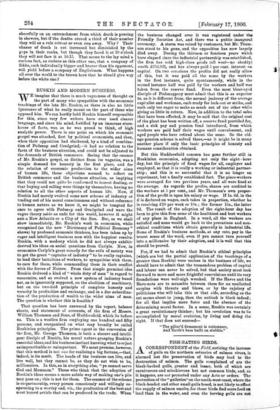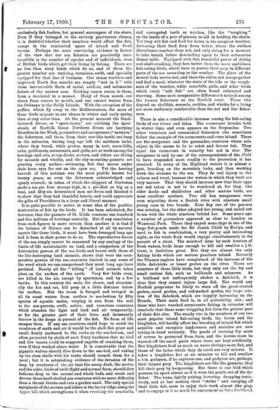FISH-EATING BIRDS.
ALCORRESPONDENT of the Field, noticing the increase of galls on the northern estuaries of salmon rivers, is alarmed lest the preservation of birds may lead to the destruction of salmon. The gulls complained of are the black-backed gulls, greater and lesser, both of which are carnivorous and mischievous but not common birds, and, as it happens, are not protected under any Acts or orders. The protection of the " gulleries" on the north-west coast, where the black-headed and other small gulls breed, is not likely to affect the supply of salmon molts, for these birds find more food on land than in the water, and even the herring gulls are not exclusively fish feeders, but general scavengers of the shore. Even if they belonged to the entirely piscivorous classes, it is doubtful whether their numbers would affect the fish, except in the contracted space of inland and fresh waters. Perhaps the most convincing evidence in favour of the view that our sea fisheries are practically inex- haustible is the number of species and of individuals, even of British birds which get their living by fishing. There are no less than sixty kinds which do so, and of these the greater number are untiring, voracious, swift, and specially equipped for that line of business. Our steam trawlers and improved North Sea smacks are simply "not in it" with these innumerable fleets of aerial, surface, and submarine fishers of the narrow seas. Nothing comes amiss to them, from a mackerel to a mussel. Many of them search our rivers from source to month, and our coastal waters from the Orkneys to the Scilly Islands. With the exception of the puffins, which fly away to the Mediterranean, far more of these birds migrate to our shores in winter and early spring than at any other time. At the present moment the black- throated divers, or " sprat-loons," are catching the sprat shoals of Norfolk, Great Northern divers are harrying flounders in the Wash, goosanders and mergansers (" sawyers," the fishermen call them, from their saw-like teeth) are busy in the estuaries, having long ago left the northern lochs, where they breed, while grebes, many in sort, razor-bills, auks, guillemots, cormorants, and gulls, are at work among the herrings and eels, scanp-ducks, scoters, and eiders are diving for mussels and whelks, and the sky-mounting gannets are piercing every surface - swimming fish that moves under their keen eyes far out on the open sea. Yet the herring harvest of this autumn was the most prolific known for twenty years, as even the fishermen acknowledged and openly avowed ; in token of which the skippers of G-orleston made a sea-pie four storeys high, in a pie-dish as big as a boat, and fifty-six determined men sat down and finished it to show that they had thankful hearts, and could appreciate the gifts of Providence in a large and liberal manner.
It is quite possible to arrive at some idea of the positive destruction of fish by the birds. It has been calculated, for instance, that the gannets of St. Kilda consume one hundred and five millions of herrings annually. But if any conclusion from such figures is more certain than another it is that if the balance of Nature can be disturbed at all by natural agents like these birds, it must have been deranged long ago had it been in their power to do so. The reproductive forces of the sea simply cannot be measured by any analogy of the limits of life maintainable on land, and a comparison of the destructive powers of the sea-birds and beasts with those of the life-destroying land animals, shows that were the recu- perative powers of the sea-creatures limited in any sense of the word which we can comprehend they must long ago have perished. Nearly all the " killing " of land animals takes place on the surface of the earth. Very few birds even, are killed in the air, except by sportsmen, and by a few hawks. In this country the mole, the shrew, and occasion- ally the fox and rat, kill prey at a little distance below the surface. But the ocean is foraged and ravaged in all its coast waters from surface to sea-bottom by fifty species of aquatic moles, varying in size from the seal to the sea-parrots, swift, active, and voracious creatures which abandon the light and land and air temporarily, or for the greater part of their lives, and incessantly burrow in the deeps in pursuit of the fish. No form of life escapes them. If any sea creatures could hope to avoid the creatures of earth and air it would be the shell-fish great and small, firmly anchored to the rocks on the sea-bottom, and often protected by shells of such flinty hardness that no bird and few beasts could be supposed capable of crushing them, even if they worked above water. It is conceivable that the gigantic walrus should dive down to the sea-bed, and raking up the clam shells with his tusks should crunch them for a meal ; but it is astonishing evidence of the invasion of the deep by creatures of the air that the scaup duck, the scoter, and the eider, birds of swift flight and normal form, should dive fathoms deep to the mussel and whelk beds, and crush and devour these hard-shelled sea-creatures with no more difficulty than a thrush breaks and eats a garden snail. The only special equipment of the scoters and eiders is the heavy ridge along the upper bill which strengthens it when crushing the sea-shells, and corrugated teeth or notches, like the " roughing " on the inside of a pair of pincers, to aid in holding the shells. Yet they will fish and feed for hours in the roughest weather, devouring their food deep down below, where the surface disturbance reaches them not, and only rising for a moment to take breath before descending again to their submarine dinner table. Equipped with this wonderful power of diving and shell-crushing, they fare better than the more ambitious fish-eating birds, which have to pursue their prey in different parts of the sea according to the weather. The place of the mussel beds moves not, and there the eiders and scaups gather and find a meal, whatever the state of the tide or the rough- ness of the weather, while razorbills, gulls, and other birds which catch "soft fish" are often found exhausted and starving. Some such comparative difference is noticed among the human fishermen on the Norfolk coast. Those who depend on shellfish, mussels, cockles, and whelks for a living are more uniformly comfortable than the net and line fisher- men.
There is also a considerable increase among the fish-eating birds of our rivers and lakes. The cormorant invades both in winter time, and even appears on the Serpentine. Two other voracious and ornamental fishermen also sometimes follow the example of the cormorants and come inland. These are the merganser and the goosander, creatures whose sole object in life seems to be to catch and devour fish. They equal the cormorant in voracity but not in size. The merganser is said by one of the correspondents of the Field to have responded most readily to the protection it has received. In many of the Highland waters it is almost a pest, breeding on the mountain lochs, and then working down the streams to the sea. They do real injury to the salmon and trout, because the waters in which they work are very narrow. That they should increase now that their eggs are not taken is not to be wondered at, for they, like eider ducks and sheldrakes and other marine birds, are most excellent mothers. Two old hen mergansers were seen migrating down a Scotch river with nineteen small young ones in two broods. Next day one of the parents was missing, but the other adopted her young, and sailed out to sea with the whole nineteen behind her. Some years ago a number of goosanders appeared as close to London as Wanstead Park. There they stayed some days in one of the large fish-ponds made for Sir Josiah Child by Evelyn, and used to fish in combination, a very pretty and interesting sight, as the whole flock would engage simultaneously in the pursuit of a shoal. The mischief done by such hunters of fresh waters, birds large enough to kill and swallow a 9 lb. trout, is doubtless great. But they are almost the only fishing birds which are serious poachers inland. Recently the Thames anglers have complained of the increase of the little dabchicks or lesser grebes on the river. There are numbers of these little birds, but they only eat the fry and small useless fish, such as bullheads and minnows. As a bullhead not unfrequently chokes a dabchick, it ie clear that they cannot injure large fish. Nor would any Norfolk proprietor be likely to warn off the great crested grebes, eared grebes, and red-necked grebes, the large rela- ives of the dabchick, which are happily increasing on the Broads. Their main food is, in all probability, eels ; and those who have watched cormorants fishing in estuaries will conclude that these same wriggling fish form the greater part of their diet also. The steady rise in the numbers of our two most popular inland fish-eating birds, the heron and the kingfisher, will hardly affect the breeding of inland fish which sensible and energetic landowners and societies are now taking in hand seriously. The ponds of teaming fry must of course be protected from them, and the herons must be warned off the small pools where trout are kept artificially. But kingfishers feed as much on water shrimps as on fish, and those of the latter which they do catch are very minute. It takes a kingfisher five or six minutes to kill and swallow a 4 in. gudgeon, if be captures one, and gudgeon are, perhaps, their largest prey. The kingfishers are like the gannets; they kill their prey by harpooning. Bat there is one bird which pursues its sport almost as if it were the gentle art of the fly- fisher. The terns, lightly poising, hovering, dropping tenta- tively, and at last making their " strike " and carrying off their little fish, seem to enjoy their work almost like play, and to engage in it as much for amusement as for a livelihood.







































 Previous page
Previous page